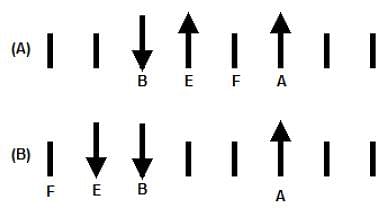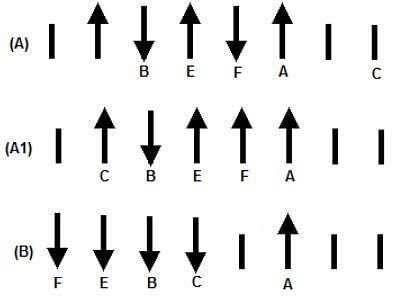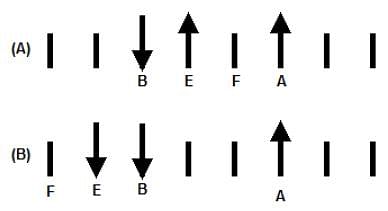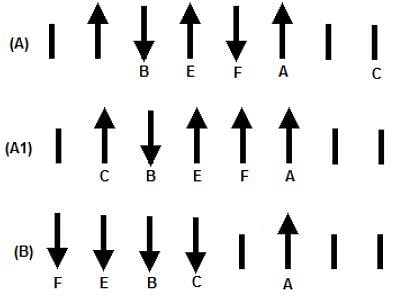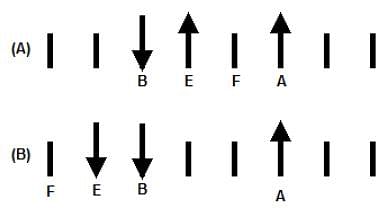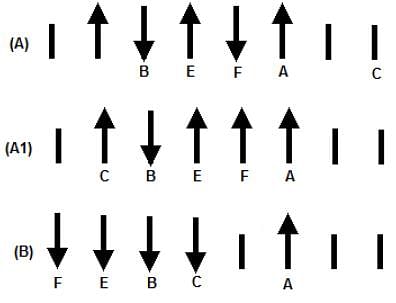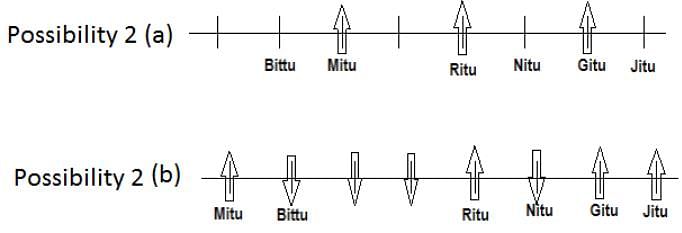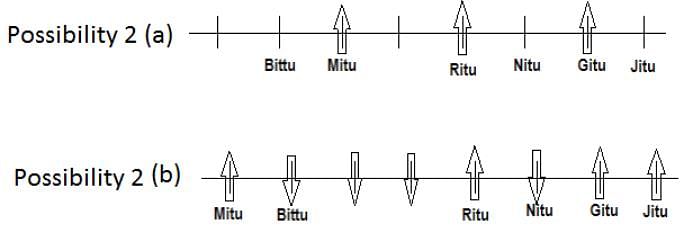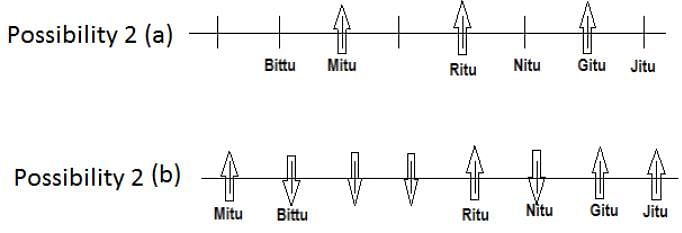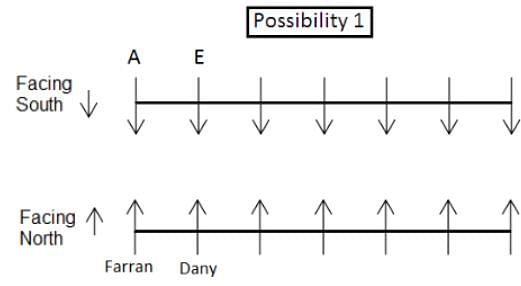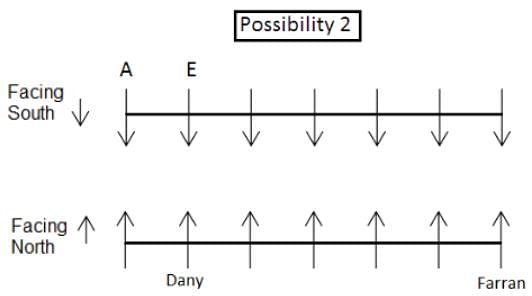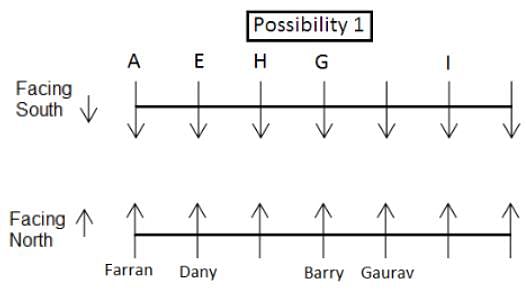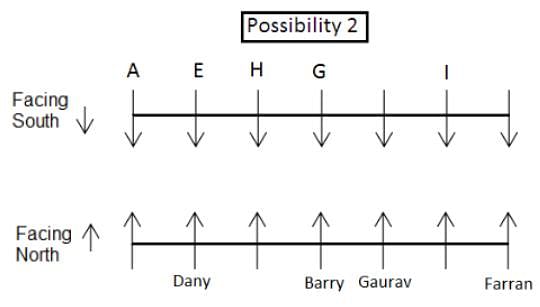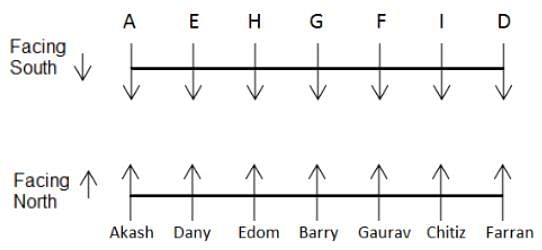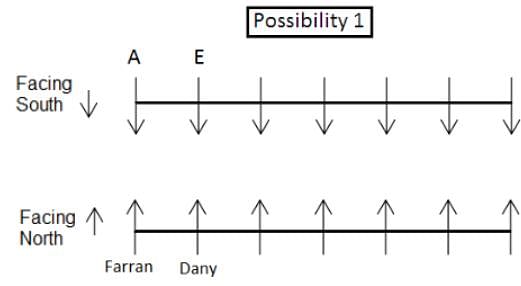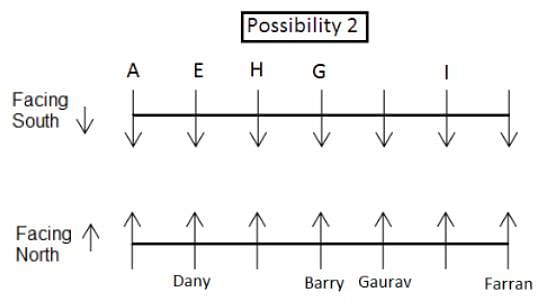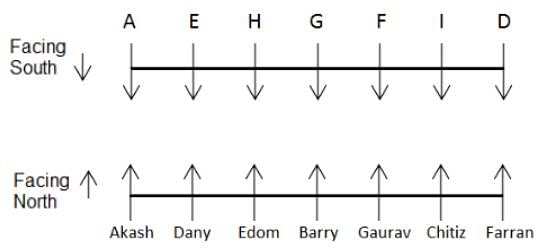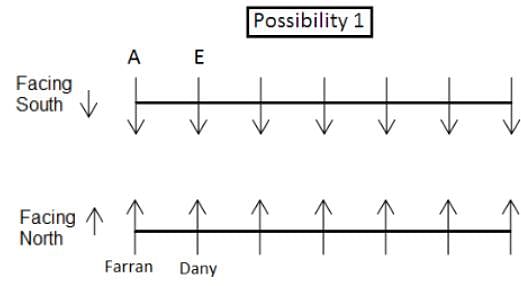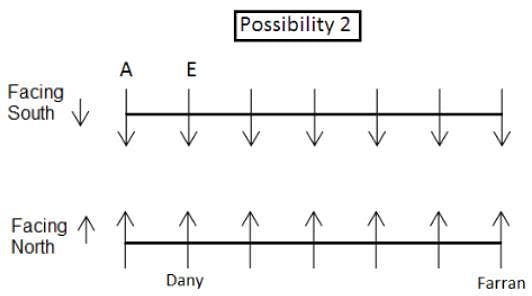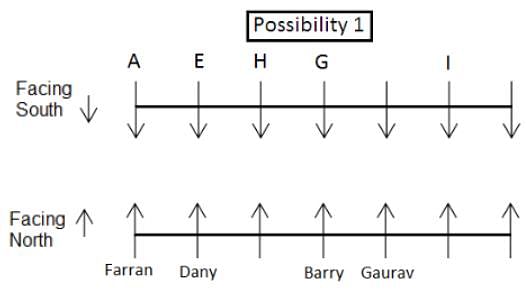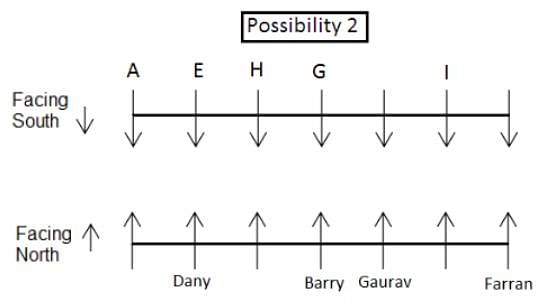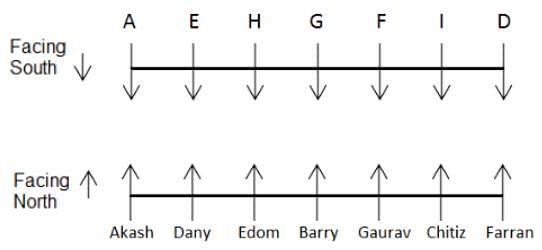This EduRev document offers 15 Multiple Choice Questions (MCQs) from the topic Seating Arrangement (Level - 1). These questions are of Level - 1 difficulty and will assist you in the preparation of CAT & other MBA exams. You can practice/attempt these CAT Multiple Choice Questions (MCQs) and check the explanations for a better understanding of the topic.
Eight friends A, B, C, D, E, F, G and H are sitting in a row, but not necessarily in the same order. Some of them are facing north and some of them are facing south. Only two people sit to the right of A. B sits third to the left of A. Only one person sits between B and F. F sits to the immediate right of E. Both the immediate neighbours of B face the same direction. C sits third to the left of F. B faces the direction opposite to what A faces. G does not sit at any of the extreme ends of the row. D faces the same direction as E. Both C and G face the opposite direction to H. A is facing north. Only one person sits between E and H. Q. Who among them are sitting exactly in the middle of the row?
Eight friends A, B, C, D, E, F, G and H are sitting in a row, but not necessarily in the same order. Some of them are facing north and some of them are facing south. Only two people sit to the right of A. B sits third to the left of A. Only one person sits between B and F. F sits to the immediate right of E. Both the immediate neighbours of B face the same direction. C sits third to the left of F. B faces the direction opposite to what A faces. G does not sit at any of the extreme ends of the row. D faces the same direction as E. Both C and G face the opposite direction to H. A is facing north. Only one person sits between E and H. Q. What is A's position with respect to B?
Eight friends A, B, C, D, E, F, G and H are sitting in a row, but not necessarily in the same order. Some of them are facing north and some of them are facing south. Only two people sit to the right of A. B sits third to the left of A. Only one person sits between B and F. F sits to the immediate right of E. Both the immediate neighbours of B face the same direction. C sits third to the left of F. B faces the direction opposite to what A faces. G does not sit at any of the extreme ends of the row. D faces the same direction as E. Both C and G face the opposite direction to H. A is facing north. Only one person sits between E and H. Q. How many of them are facing north?
Ritu, Gitu, Nitu, Mitu, Bittu, Jitu, Kittu and Titu are sitting on a straight bench to play a game. Four of them are facing North while the remaining friends are facing South. Q. Which of the following members is sitting fourth to the left of Kittu?
Jitu is sitting third to the right of Ritu. Bittu is sitting third to the left of Ritu. Jitu is sitting at one of the ends of the bench. Both Jitu and another friend, who are sitting at extreme ends of the bench, are lined up towards the similar direction. The immediate neighbours of Ritu are facing opposite direction to that of Jitu.
The friends sitting to the immediate left and immediate right of Titu are facing opposite directions with respect to each other. The immediate neighbours of Nitu are facing North. Kittu is not an immediate neighbour of Ritu. Mitu is one of the immediate neighbours of Bittu and is facing North. The immediate neighbours of Gitu are Nitu and Jitu.
Ritu, Gitu, Nitu, Mitu, Bittu, Jitu, Kittu and Titu are sitting on a straight bench to play a game. Four of them are facing North while the remaining friends are facing South. Q. The given pairs are similar in some way, but one out of them is different from the rest. Find the odd one out.
Jitu is sitting third to the right of Ritu. Bittu is sitting third to the left of Ritu. Jitu is sitting at one of the ends of the bench. Both Jitu and another friend, who are sitting at extreme ends of the bench, are lined up towards the similar direction. The immediate neighbours of Ritu are facing opposite direction to that of Jitu.
The friends sitting to the immediate left and immediate right of Titu are facing opposite directions with respect to each other. The immediate neighbours of Nitu are facing North. Kittu is not an immediate neighbour of Ritu. Mitu is one of the immediate neighbours of Bittu and is facing North. The immediate neighbours of Gitu are Nitu and Jitu.
Ritu, Gitu, Nitu, Mitu, Bittu, Jitu, Kittu and Titu are sitting on a straight bench to play a game. Four of them are facing North while the remaining friends are facing South. Q. Who are the immediate neighbours of Bittu?
Jitu is sitting third to the right of Ritu. Bittu is sitting third to the left of Ritu. Jitu is sitting at one of the ends of the bench. Both Jitu and another friend, who are sitting at extreme ends of the bench, are lined up towards the similar direction. The immediate neighbours of Ritu are facing opposite direction to that of Jitu.
The friends sitting to the immediate left and immediate right of Titu are facing opposite directions with respect to each other. The immediate neighbours of Nitu are facing North. Kittu is not an immediate neighbour of Ritu. Mitu is one of the immediate neighbours of Bittu and is facing North. The immediate neighbours of Gitu are Nitu and Jitu.
Fourteen persons are sitting in two parallel rows. Akash, Barry, Gaurav, Dany, Chitiz, Edom and Farran are sitting in the same row, facing towards the North, but not necessarily in the same order. A, H, G, I, F, D and E are sitting in the same row, facing South, but not necessarily in the same order. Both the rows are parallel to each other and each person is facing a person sitting in the other row. Dany is second from the left corner of a row and is facing E. A is sitting at the corner of a row and in front of the person, who is the immediate neighbour of Dany. There are two persons between H and I. Farran is sitting at one of the corners of his row. G is not sitting at any of the corners of his row and is second to the right of I. Barry is facing G and is to the immediate left of Gaurav. There are two persons between Gaurav and Dany. F is facing the person, who is fourth to the right of Akash. F doesn't sit at any of the corners. Edom doesn't face any immediate neighbour of F. Q. Which of the following pairs represents the persons facing each other?
Fourteen persons are sitting in two parallel rows. Akash, Barry, Gaurav, Dany, Chitiz, Edom and Farran are sitting in the same row, facing towards the North, but not necessarily in the same order. A, H, G, I, F, D and E are sitting in the same row, facing South, but not necessarily in the same order. Both the rows are parallel to each other and each person is facing a person sitting in the other row. Dany is second from the left corner of a row and is facing E. A is sitting at the corner of a row and in front of the person, who is the immediate neighbour of Dany. There are two persons between H and I. Farran is sitting at one of the corners of his row. G is not sitting at any of the corners of his row and is second to the right of I. Barry is facing G and is to the immediate left of Gaurav. There are two persons between Gaurav and Dany. F is facing the person, who is fourth to the right of Akash. F doesn't sit at any of the corners. Edom doesn't face any immediate neighbour of F. Q. Which of the following combinations represents the persons who are sitting at the corners of their rows?
Fourteen persons are sitting in two parallel rows. Akash, Barry, Gaurav, Dany, Chitiz, Edom and Farran are sitting in the same row, facing towards the North, but not necessarily in the same order. A, H, G, I, F, D and E are sitting in the same row, facing South, but not necessarily in the same order. Both the rows are parallel to each other and each person is facing a person sitting in the other row. Dany is second from the left corner of a row and is facing E. A is sitting at the corner of a row and in front of the person, who is the immediate neighbour of Dany. There are two persons between H and I. Farran is sitting at one of the corners of his row. G is not sitting at any of the corners of his row and is second to the right of I. Barry is facing G and is to the immediate left of Gaurav. There are two persons between Gaurav and Dany. F is facing the person, who is fourth to the right of Akash. F doesn't sit at any of the corners. Edom doesn't face any immediate neighbour of F. Q. What is the position of Edom with respect to Farran?
A, B, C, D, E, F and G are sitting in a straight line with equal distance between each other, but not necessarily in the same order. Some of them are facing north and some are facing south. Q. Who sits exactly on the middle of the line?
Only two persons are sitting to the left of G. Only two persons are sitting between G and B. A is second to the left of B. The immediate neighbours of A are facing opposite directions (if one of the neighbours is facing south, then the other will be facing north and vice versa). Only one person is sitting between A and C. F is sitting third to the left of C. D is not an immediate neighbour of B. Both the immediate neighbours of C are facing the same direction (if one neighbour is facing north, then the other will also be facing north and if one is facing south, then the other will also be facing south). A is facing the same direction as C. E is facing north. B is sitting to the immediate left of E.
A, B, C, D, E, F and G are sitting in a straight line with equal distance between each other, but not necessarily in the same order. Some of them are facing north and some are facing south. Q. Who is sitting second to the right of D?
Only two persons are sitting to the left of G. Only two persons are sitting between G and B. A is second to the left of B. The immediate neighbours of A are facing opposite directions (if one of the neighbours is facing south, then the other will be facing north and vice versa). Only one person is sitting between A and C. F is sitting third to the left of C. D is not an immediate neighbour of B. Both the immediate neighbours of C are facing the same direction (if one neighbour is facing north, then the other will also be facing north and if one is facing south, then the other will also be facing south). A is facing the same direction as C. E is facing north. B is sitting to the immediate left of E.
A, B, C, D, E, F and G are sitting in a straight line with equal distance between each other, but not necessarily in the same order. Some of them are facing north and some are facing south. Q. Which of the following statements is true?
Only two persons are sitting to the left of G. Only two persons are sitting between G and B. A is second to the left of B. The immediate neighbours of A are facing opposite directions (if one of the neighbours is facing south, then the other will be facing north and vice versa). Only one person is sitting between A and C. F is sitting third to the left of C. D is not an immediate neighbour of B. Both the immediate neighbours of C are facing the same direction (if one neighbour is facing north, then the other will also be facing north and if one is facing south, then the other will also be facing south). A is facing the same direction as C. E is facing north. B is sitting to the immediate left of E.
Eleven persons E, F, G, H, I, J, K, L, M, N and O sit in a row facing south. G is at equal distance from J and N. H is to the immediate right of F, who is at one of the extreme ends of the row. L has equal number of persons either side. There are three persons between L and J. There is one more person to the left of I when compared to the right of K. The number of persons to the left of E is the same as the number of persons to the right of M. G is third to the left of J who is not the immediate neighbor of E. K is the immediate neighbour of G. Q. Who among the following is to the immediate left of N?
Eleven persons E, F, G, H, I, J, K, L, M, N and O sit in a row facing south. G is at equal distance from J and N. H is to the immediate right of F, who is at one of the extreme ends of the row. L has equal number of persons either side. There are three persons between L and J. There is one more person to the left of I when compared to the right of K. The number of persons to the left of E is the same as the number of persons to the right of M. G is third to the left of J who is not the immediate neighbor of E. K is the immediate neighbour of G. Q. If J is related to G and in the same way G is related to N, then to whom among the following is M related?
Eleven persons E, F, G, H, I, J, K, L, M, N and O sit in a row facing south. G is at equal distance from J and N. H is to the immediate right of F, who is at one of the extreme ends of the row. L has equal number of persons either side. There are three persons between L and J. There is one more person to the left of I when compared to the right of K. The number of persons to the left of E is the same as the number of persons to the right of M. G is third to the left of J who is not the immediate neighbor of E. K is the immediate neighbour of G. Q. Who two among the following are the immediate neighbours of the persons sitting at the extreme ends?
FAQs on Seating Arrangement Questions for CAT with Answers PDF
| 1. What is a seating arrangement CAT exam? |  |
| 2. How can I improve my skills in solving seating arrangement questions? |  |
| 3. Are there any strategies to solve seating arrangement questions quickly? |  |
| 4. What are the common mistakes to avoid while solving seating arrangement questions? |  |
| 5. How can I manage time effectively while solving seating arrangement questions in CAT? |  |

|
Explore Courses for CAT exam
|

|
